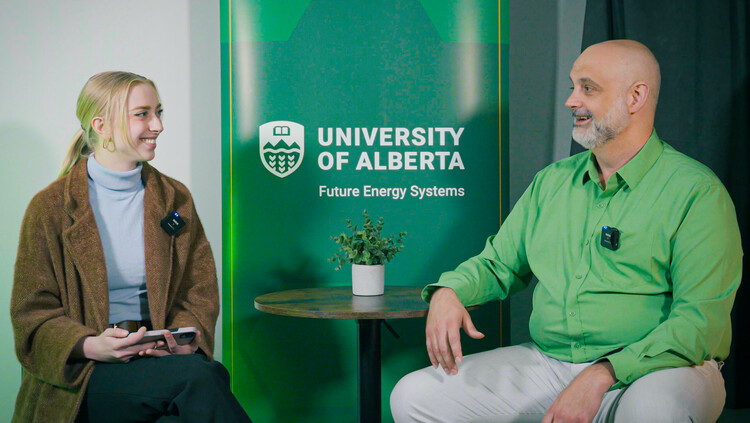The Project Report: Making a Meal from Methanol
Posted on
FES Research Communications Coordinator Elyse Dzenick interviews Dr. David Bressler for the Project Report
When it comes to researching the future of energy, making building blocks for animal feedstock proteins isn’t the first thing that comes to mind. But that’s exactly what’s happening at the University of Alberta’s Faculty of Agriculture, Life, and Environmental Sciences.
The Bressler Lab, led by Dr. David Bressler, is a bioconversion lab that primarily employs chemistry for biorefining and fermentation. Essentially, they change by-products from industry that would normally be considered waste into other usable products. And they’ve found a way to transform coal, in the form of methanol, into food:
“The conversion process is very similar to yogurt, only instead of probiotics, we’re left with high-value amino acids, which are protein building blocks for feedstock,” David explains.
Inside the Bressler Lab, the team studies how enzymes, microbes, chemistry, and high-temperature chemistries can be applied to conversion processes in the agricultural and pharmaceutical industries. Their research also has a big focus on minimizing the amount of carbon dioxide released during each step of the conversion process:
“We try to incorporate circular economy principles in as much of the research as we can. When each step of the process can reduce how much carbon dioxide is released, the whole system becomes more sustainable overall,” David clarifies.
Similar to the process of making yogurt, the methanol conversion process begins with a singular organism—except the Bressler Lab organism converts methanol into amino acids, instead of sugar into probiotics. The organism is carefully and timely fed to maximize its growth rate. Once the seed culture grows to the desired cell concentration, the researchers add the organism to a 5L fermenter, where it undergoes a continuous fermentation process that results in approximately one-fifth of the fermenter volume, containing concentrated cells that are being harvested every half hour.
“It’s a team effort, there’s always someone working on the system,” notes David. “Grad students analyze different parts, so some may work on the conversion process, while some examine fermentation or manage the recovery, and others examine the downstream process and longer-term strategies.”
Partnering Up with Industry & the Past
Scientific developments are rarely the result of efforts from a single party, and a network of partnerships has opened doors to connections across the University of Alberta campus and beyond. For example, graduate students at the Bressler Lab uniquely refine their research design skills by engaging with industry partners and collaborative researchers. Consistent meetings encourage active feedback, which the students learn to take into account when designing future projects.
For the students, these partnerships also challenge the way research is communicated and open a world of opportunity for their next career step:
“We’ve been incredibly fortunate to partner with the scientists from Europe who originally developed the process in the 1970s and 80s,” says David. “Current grad students meet every other week or so to train directly under the experts who invented the very process they’re refining. It’s an amazing opportunity to pick their brains and forge their own industry connections and future career paths.”
Partnerships with companies, like Alberta-based startup Cv̄ictus, have also sped up getting to market by patenting the process. The company converts hydrogen recovered from deep coal seams without mining, then converts it to methanol. Any excess carbon is recaptured, then resequestered, which aligns with Bressler’s circular economy focus.
To the Future & Beyond
Recently, the Bressler Lab was part of a $1.7M funding announcement with the Bill and Melinda Gates Foundation, which will support field trials of blending the single-cell protein into feedstock with the help of the University of Alberta’s Agri-Food Discovery Place.
Thanks to the grant and a partnership with Dr. Ruurd Zijlstra, who is leading the research, the next two years of this research will be spent testing the viability of the high-protein feedstock by testing it with poultry and pigs in Alberta. Eventually, Cvictus aims to build a facility near Red Deer. Pending the success of the field trials, the single-cell protein technology could improve sustainability throughout Canada’s agriculture sector by lowering CO2 emissions and decreasing production costs.
“There’s a popular opinion that there’s a straight line from academia to the business world,” David conveys. “In reality, it’s a lot more complicated than that—there’s a lot of back and forth with other researchers, institutions, and companies, and different interests to balance.
“At the end of the day, we all care about the impact on our communities and society. People want to see impact from their careers.”
Further Reading:
Alberta researchers aim to revolutionize animal feed | Folio.
Turning coal into food | CBC Radio Active On Demand
University of Alberta researchers making animal feed from coal